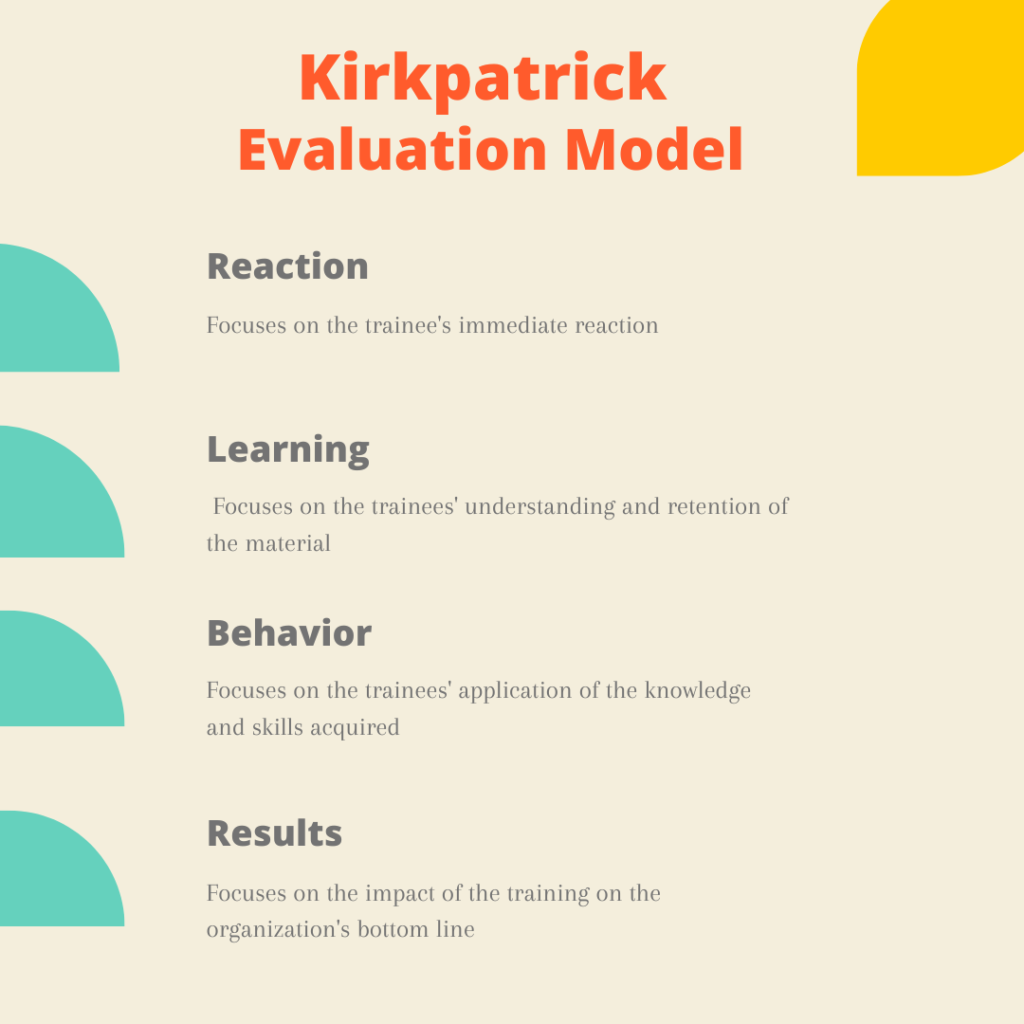The Kirkpatrick Model, also known as the Kirkpatrick Four-Level Training Evaluation Model, is a framework used to evaluate the efficacy of training programs. Developed by Donald Kirkpatrick in the 1950s, the model has become a widely accepted method for evaluating the success of training initiatives in organizations. In this post, we will learn about four levels of the Kirkpatrick Model: Evaluation: Reaction, Learning, Behavior, and Results.

Reaction
The first level of evaluation is Reaction. This level focuses on the trainee’s immediate reaction to the training program. This can be measured through surveys or interviews, and the goal is to gather feedback on the trainees’ overall satisfaction with the training, the relevance of the content, and the quality of the instruction. This level of evaluation provides insight into whether the training program met the trainees’ expectations and whether any changes need to be made to improve the program in the future.
Learning
The second level of evaluation is learning. This level focuses on the trainees’ understanding and retention of the material presented during the training. This can be measured through assessments such as quizzes, exams, or observations of the trainees’ performance. The goal is to determine whether the trainees have acquired the knowledge and skills necessary to perform their job tasks effectively.
Behavior
The third level of evaluation is behavior. This level focuses on the trainees’ application of the knowledge and skills acquired during the training in the workplace. This can be measured through observations of the trainees’ performance, interviews with supervisors, or analysis of performance data. The goal is to determine whether the training has resulted in improved job performance and whether the trainees are using the knowledge and skills acquired during the training in their everyday work.
Results
The fourth and final level of evaluation is results. This level focuses on the impact of the training on the organization’s bottom line. This can be measured through analysis of data such as productivity, quality, and customer satisfaction. The goal is to determine whether the training has resulted in improved organizational performance and whether the investment in the training program was worth it.

Advantages of using Kirkpatrick Model
One of the key advantages of the Kirkpatrick Model is its ability to provide a comprehensive evaluation of the training program. By evaluating the training program at each level, organizations can gain insight into the effectiveness of the program at different stages. The model also allows organizations to identify specific areas of the program that need improvement and make changes accordingly.
Another advantage of the Kirkpatrick Model is its flexibility. The model can be applied to any type of training program, whether it be technical training, management development, or sales training. Additionally, the model can be used to evaluate both instructor-led and online training programs.
Limitations of Kirkpatrick Model
However, it’s important to note that the Kirkpatrick Model is not without its limitations. The model requires a significant investment of time and resources to conduct the evaluations at each level. Additionally, the model does not take into account the impact of external factors such as changes in the business environment, which may affect the results of the training program.
Conclusion
The Kirkpatrick Model is a widely accepted framework for evaluating the effectiveness of training programs. By evaluating the training program at each level, organizations can gain insight into the effectiveness of the program at different stages and make necessary changes to improve it. The model is flexible and can be applied to any type of training program. However, it does have its limitations, and organizations must consider these when using the model.
You can watch this video to get more clarity on the training evaluation methodology.





Leave a Reply